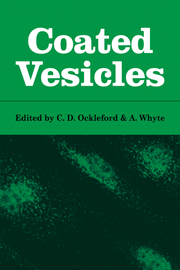Book contents
- Frontmatter
- Contents
- Preface
- Foreword
- List of contributors
- 1 Coated vesicles: a morphologically distinct subclass of endocytic vesicles
- 2 Coated vesicles in different cell types: some functional implications
- 3 Coated vesicles: their occurrence in different plant cell types
- 4 Immunoglobulin transmission in mammalian young and the involvement of coated vesicles
- 5 Coated vesicles in neurons
- 6 Coated vesicles in the oocyte
- 7 Adsorptive and passive pinocytic uptake
- 8 Coated vesicles and receptor biology
- 9 Coated secretory vesicles
- 10 Dynamic aspects of coated vesicle function
- 11 Structural aspects of coated vesicles at the molecular level
- 12 Coated vesicles in medical science
- Appendix 1 Nomenclature
- Appendix 2 References added at proof
- Author index
- Subject index
- Plate section
2 - Coated vesicles in different cell types: some functional implications
Published online by Cambridge University Press: 04 August 2010
- Frontmatter
- Contents
- Preface
- Foreword
- List of contributors
- 1 Coated vesicles: a morphologically distinct subclass of endocytic vesicles
- 2 Coated vesicles in different cell types: some functional implications
- 3 Coated vesicles: their occurrence in different plant cell types
- 4 Immunoglobulin transmission in mammalian young and the involvement of coated vesicles
- 5 Coated vesicles in neurons
- 6 Coated vesicles in the oocyte
- 7 Adsorptive and passive pinocytic uptake
- 8 Coated vesicles and receptor biology
- 9 Coated secretory vesicles
- 10 Dynamic aspects of coated vesicle function
- 11 Structural aspects of coated vesicles at the molecular level
- 12 Coated vesicles in medical science
- Appendix 1 Nomenclature
- Appendix 2 References added at proof
- Author index
- Subject index
- Plate section
Summary
Ample evidence indicates that coated vesicles are commonly occurring structures in different cell types in a diversity of animal species. Coated vesicles have been demonstrated in cells under physiological and experimental conditions, in vivo and in vitro, as well as in pathological situations. It is necessary, therefore, to examine the possibility that coated vesicles are ubiquitous structures and to record their occurrence in different animals, different cell types, and under varying cell-environmental conditions.
In a recent article an attempt has been made to review the information pertinent to coated vesicles and their function (Nevorotin, 1977). From an analysis of this and of further original observations it may be concluded that there are several distinct groups of coated vesicles. These all share a similar if not identical structural organisation of an external lattice structure and membranous vesicle wall, but differ in their vesicular contents, the route the coated vesicle apparently follows within the cytoplasm, and their contribution to cellular metabolism.
This chapter presents a comparative analysis of coated vesicles and their function but deals only briefly with the literature in the specific areas dealt with in later chapters.
Morphological aspects: general comments
There is more than one ultrastructurally distinct entity which has been termed a coated vesicle. The structure generally observed and tentatively related here to a principal class is characterised, when viewed in median ultrathin section, as a sphere bounded by unit membrane, with several projections, 15–20 nm in length, radiating from the external surface.
Information
- Type
- Chapter
- Information
- Coated Vesicles , pp. 25 - 54Publisher: Cambridge University PressPrint publication year: 1980
Accessibility standard: Unknown
- 8
- Cited by
